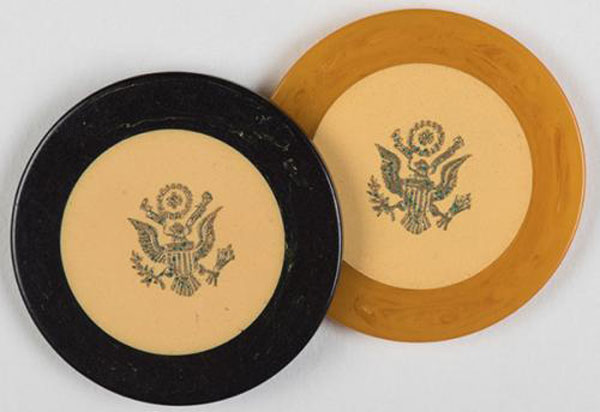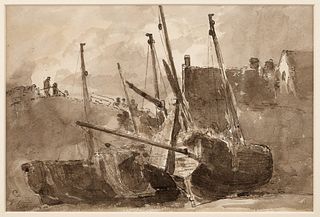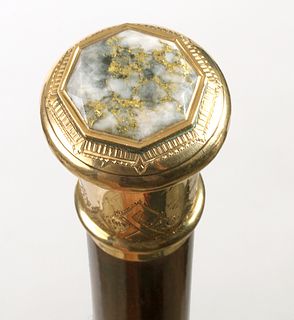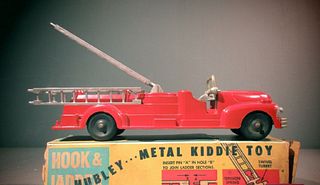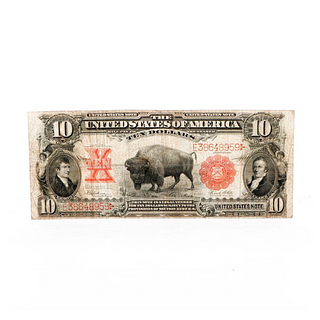A Taste for Fine Gambling Chips
What did Herbert Hoover and Napoleon Bonaparte have in common? Besides being heads of state, both had a taste for fine gambling chips, apparently.
At least that much is to be gathered from the offerings included in the annual sale of gambling memorabilia to be held by Potter & Potter Auctions in Chicago. The May 21 Two of a Kind auction includes antique playing cards, rare books, cheating devices, gambling equipment, poker chips, artwork, and vintage advertising.
The aforementioned chips come from the collection of Dale Seymour, the author of a well-known reference work on the subject, Antique Gambling Chips, in which these and many other of the chips in the sale first appeared.
Pair of Napoleonic Chips, Lots 393-94, Estimate $3,000-5,000 each
Seymour ranks the pair of Napoleonic chips (Lots 393 – 94), which bear an imperial bee symbol at the center, among the rarest in his collection. Potter & Potter adds that these examples were separated long ago from a larger matching set of the emperor’s chips now in the collection of the Wallace Museum in London.
For his part, much less is expected of Hoover. Two of his chips (Lot 391), embossed with the presidential seal, are estimated at $200 – 400.
Herbert Hoover-Owned Pair of Bakelite Poker Chips. American, ca. 1930, Estimate $200-400
The auction opens with a section of books, the most desirable being first editions of early works that exposed crooked gamblers’ methods of cheating and advantage play, including The Little Secrets (Lot 4), The Expert at the Card Table (Lot 34), Koschitz’s Manual of Useful Information (Lot 71), and Treatise on Advantage Card Playing and Draw Poker (Lot 103). Those titles are estimated to snag several thousand dollars apiece, but the majority are likely to sell for between $100 – 300.
Like the literature, objects and equipment linked to cheating are expected to receive special attention, and in the second half of the auction a separate section has been devoted to such paraphernalia.
Two cold-deck holdouts (Lots 331 – 32), manufactured approximately 100 years apart but operating on about the same principle, are waist-worn devices that secretly deliver a full stacked deck of cards into the player’s hands. The antique example is estimated to bring in $2,500 – 3,500.
Lots 333 – 37 are Kepplinger holdouts. The lead-off example incorporates a sleeve guard that went further than other devices in ensuring against detection around shirt cuffs.
Dice edgers, a gaffed keno goose, an even a matchbox equipped with a tiny mirror to read cards as they were dealt fill out the same section.
- Quilts as a 2025 Design Trend: A Celebration of American Heritage and Craftsmanship
- A Celebration of Sports History and Collectibles
- Antiques and the Arts Weekly Q&A: Allis Ghim
- The Thrill of Sports Memorabilia Auctions: A Collector’s Paradise
- Demystifying Coin Condition: A Guide to the Sheldon Grading Scale
- Snoopy & Friends: A “Peanuts” Auction at Revere
- Colorful Chinese Monochromes at Millea Bros
- 12 Holiday Gifts for the “Impossible to Buy For” on Bidsquare
- Alluring Art Objects and Accessories from the Estate of Chara Schreyer
- Kimball Sterling's One-Owner Outsider and Folk Art Collection Showcases Masters of the Unconventional



 EUR
EUR CAD
CAD AUD
AUD GBP
GBP MXN
MXN HKD
HKD CNY
CNY MYR
MYR SEK
SEK SGD
SGD CHF
CHF THB
THB
